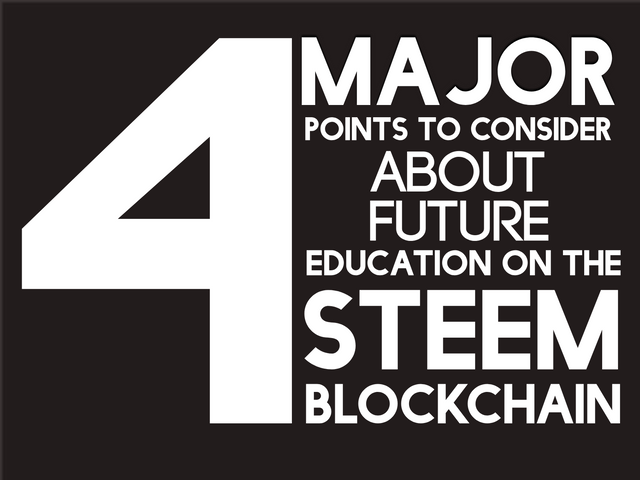Learning On The Steem Blockchain

The Steem Blockchain for Learning
After recently watching the 2019 Steem Fest recap I began contemplating the future direction of Communities and SMTs. I imagined a breakthrough scenario for the Steem blockchain. In this post I would like to introduce the idea of using the Steem blockchain to facilitate a decentralized and open learning platform. As to my knowledge, there currently does not exist such a resource available to the public. As for those who have been aware of current trends, the education industry is going through somewhat of a major shakeup. This of course leads to uncertainty but also opportunities, hence, the rise of such players as Udacity™, Udemy™, and Skills Share ™ among others in the learning space.
The new players on the block have some particularly attractive options for active learners and offer programs that can often be customized to fit individual learning needs. Subjects on offer cover a wide variety of topics and in some cases present the possibility of earning accredited certificates. Courses are available from both traditional institutions and non-affiliated providers. And with students facing soaring tuition costs within higher education, many have opted to pursue non traditional routes to further their educational and personal development.
Another emerging trend is the rise of open artificial intelligence projects and standards that have the potential to unleash unparalleled knowledge acquisition and skills development.
Let me say upfront that I am not a subject matter expert on this topic but would like to spark the reader's imagination and hopefully lead to productive conversations and innovative ideas as to how learning on the Steem blockchain might work.
The Business Case
The learning environment provides students with cost effective and easy to access subject matter and helps them to attain their learning objectives. Instructors have the widest degree of flexibility in forming course materials and retain full ownership and rights to the materials. Overhead costs are kept to a minimum. Instructors receive direct earnings minus nominal transaction and administrative fees. SMTs may act as a means of payment when pegged to the USD. Comunities can serve as virtual classrooms. Academic achievements can be published to the blockchain. And what is perhaps the greatest differentiator between traditional learning systems and one based on the Steem Blockchain is that of transparency and immutability.
What follows is a list of considerations organized into four catagories on the merits and challenges of a learning system on the Steem blockchain followed by a brief conclusion of possible future implications.
Strengths
There are a number of characteristics that set Steem apart from other platforms on and off the web and the following list is not exhaustive and readily comes to mind as some competitive advantages that Steem could offer:
- Cost containment by eliminating middlemen
- Low transaction fees
- Scalability
- Greater flexibility in the development and distribution of course curricular
- Accessibility of course materials
- Through "Communities" students can tutor and assist in the teaching of otheer students
- Assisted learning through open source AI (artificial intelligence) APIs that support backend off-chain services.
Weaknesses
Steem is a relatively new infrastructure and as such there are a number of areas that could hinder the success of maintaininga viable learning system in a number of areas:
- Winning approval from accreditation bodies
- Regulatory compliance accross jurisdictions
- Disbute resolution and user retention
- Crypto price volatility.
Opportunities
The education market is crowded and competition abounds. Therefore, those wishing to gain a foothold in this space should consider taking an unconventional route and gain numerous advantages:
- Market exposure, distribution and influence through DAPPs (decentralized applications), i.e., DTube, DSound and Bitchute, etc.
- Acces to learners from around the world
- Tap into the potential of underserved markets (domestic and abroad)
- Build brand loyalty
- Win business away from traditional providers
- Gain extra business through unsolicited referrals.
Threats
Despite the many rapid changes that are taking place within the field of learning, again driven to a great extent by need of learners to access lower cost high quality resources, legacy institutions are incumbered by layers of bureaucracy and vested interest and may strive to defend "their turf" by maintaining the status quo. With that being said, here are number of factors that could negatively impact the enterprise of learning on the blockchain:
- Large commercial providers (potentially large marketing budgets)
- Regulatory bodies
- Special interest groups (e.g., alumni from legacy institutions)
- Accreditation boards
- Negative media coverage.
Conclusion
As previously stated, the learning paradigm is in a state of great transformation. This introduces a number of unknowns but simultaneously means that the barriers to entry are beginning to fall. Learners have an ever expanding range of options and are increasingly willing to pursue non traditional routes in meeting their needs. Those who are willing to innovate on the blockchain and who can offer a compelling experience, will blaze new trails and benefit financially as a result.
There will always be a frontier where there is an open mind and a willing hand.
-Charles F. Kettering
References
- Future of Education: Breaking The Connection Between Learning and Assessment - Epic 2020,
mastermind.org - Decentralized and Collaborative AI: How Microsoft Research is Using Blockchains to Build More Transparent Machine Learning Models, towardsdatascience.com
- Open AI https://openai.com/charter/
- 2019 EdTech Trends You Should Be Excited About, https://elearningindustry.com/2019-edtech-trends-excited